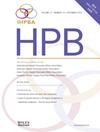常规记叙式CT报告是否能提供足够的信息以适当分期胰腺癌?
IF 2.4
3区 医学
Q2 GASTROENTEROLOGY & HEPATOLOGY
引用次数: 0
摘要
背景:胰腺导管腺癌(Pancreatic ductal adencarcinoma, PDAC)的分期使用CT成像,通常以叙述性的散文形式报道,这可能会忽略对外科医生至关重要的关键细节。本研究评估了63种来自国际共识指南(ICG)的潜在放射描述符,以对PDAC的可切除状态进行分类,以确定报告是否充分分期PDAC。方法:作为SCANPatient试验的一部分,从澳大利亚19家医院(2023年7月至12月)收集了150例确诊PDAC患者的CT报告。报告是根据63个相关特性中有多少被处理来评估的。结果:不到一半的相关领域在散文报告中得到了适当的处理(41.1%,平均26个相关领域中的10.7%,因为并非所有领域都与每个案例相关)。不到35%的报告充分地讨论了肿瘤血管与肠系膜上动脉和静脉的关系。乳糜动脉仅在30例(20%)报告中被提及,术语不规范和模糊是常见的。结论:澳大利亚关于PDAC可切除性的散文CT报告并没有明确指出许多决定可切除性的重要特征。散文报道存在着相关否定省略率高、委托错误多、语言差异大等问题。本文章由计算机程序翻译,如有差异,请以英文原文为准。
Do routine narrative style CT reports provide sufficient information to adequately stage pancreatic cancer
Background
Pancreatic ductal adenocarcinoma (PDAC) is staged using CT imaging generally reported in a narrative prose style, which can omit key details critical for an operating surgeon. This study assessed sixty-three potential radiological descriptors derived from the International Consensus Guidelines (ICG) to classify the resectability status of PDAC to determine whether reports adequately staged PDAC.
Methods
150 CT reports from patients with confirmed PDAC were collected from 19 hospitals across Australia (July–December 2023), as part of the SCANPatient trial. Reports were evaluated based on how many of the 63 relevant features were addressed.
Results
Less than half all relevant fields were appropriately addressed in prose reports (41.1 %, 10.7 of an average 26 relevant fields, as not all fields were relevant for each case). Less than 35 % of reports adequately addressed the tumour–vessel relationship with the superior mesenteric artery and vein. The coeliac artery was addressed in just 30 reports (20 %), and non-standard and vague terminology was common.
Conclusion
Prose CT reporting for PDAC resectability in Australia does not specifically address many important features determining resectability. Prose reporting is associated with high rates of omission of relevant negatives as well as some errors of commission and considerable language variability.
求助全文
通过发布文献求助,成功后即可免费获取论文全文。
去求助
来源期刊

Hpb
GASTROENTEROLOGY & HEPATOLOGY-SURGERY
CiteScore
5.60
自引率
3.40%
发文量
244
审稿时长
57 days
期刊介绍:
HPB is an international forum for clinical, scientific and educational communication.
Twelve issues a year bring the reader leading articles, expert reviews, original articles, images, editorials, and reader correspondence encompassing all aspects of benign and malignant hepatobiliary disease and its management. HPB features relevant aspects of clinical and translational research and practice.
Specific areas of interest include HPB diseases encountered globally by clinical practitioners in this specialist field of gastrointestinal surgery. The journal addresses the challenges faced in the management of cancer involving the liver, biliary system and pancreas. While surgical oncology represents a large part of HPB practice, submission of manuscripts relating to liver and pancreas transplantation, the treatment of benign conditions such as acute and chronic pancreatitis, and those relating to hepatobiliary infection and inflammation are also welcomed. There will be a focus on developing a multidisciplinary approach to diagnosis and treatment with endoscopic and laparoscopic approaches, radiological interventions and surgical techniques being strongly represented. HPB welcomes submission of manuscripts in all these areas and in scientific focused research that has clear clinical relevance to HPB surgical practice.
HPB aims to help its readers - surgeons, physicians, radiologists and basic scientists - to develop their knowledge and practice. HPB will be of interest to specialists involved in the management of hepatobiliary and pancreatic disease however will also inform those working in related fields.
Abstracted and Indexed in:
MEDLINE®
EMBASE
PubMed
Science Citation Index Expanded
Academic Search (EBSCO)
HPB is owned by the International Hepato-Pancreato-Biliary Association (IHPBA) and is also the official Journal of the American Hepato-Pancreato-Biliary Association (AHPBA), the Asian-Pacific Hepato Pancreatic Biliary Association (A-PHPBA) and the European-African Hepato-Pancreatic Biliary Association (E-AHPBA).
 求助内容:
求助内容: 应助结果提醒方式:
应助结果提醒方式:


